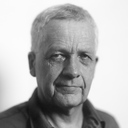0 Likes
الناز فرج اللهی: نگاه خیره ی زنان
نوشته ی Jareh Das
ترجمه ی نیکو ترخانی
الناز فرج اللهی، نقاش ایرانی، بیشتر به سبک و روشی کار می کند که می توان آن را با عبارت «صورتگری ترکیبی» توصیف کرد. این سبک صورتگری سنتی را با عناصری معاصرتر به هم می آمیزد؛ و صحنه ای پدید می آورد که میان جهان متصور و جهان واقع قرار دارد. صورت ها در قابی تصویر شده اند که گاه شامل مو، پوست، خز و مواد براق کننده است و کیفیت سطح آثار را زنده و پرطراوت می سازد.
این نقاشی ها، ترکیب موادی است که معمولا شامل آکریلیک به علاوه ی مواد براق کننده است. ترکیب این دو ماده به کارماده ای بدل می شود که القا کننده ی جوانی و سرمستی است. این هنرمند عناصر خودبیانگر زنانگی - خود و نقش زنان در جامعه ی معاصر - را به هم می آمیزد و بدین سان سوژه ی زنانگی را بدل به عنصر کلیدی فعالیت هنری خود می کند.
نقاشی های او به شکلی پیوسته میان مرزهای ادراک کلیشه ای از زن و شناخت زن از جایگاه خود در جهان، جا به جا می شود.
فرج اللهی طی چندین سال کار و به واسطه ی نقاشی هایش، به بیانه ای بیرونی ودیداری از شناخت درونی شخصیت زن دست یافت. می توان مجموعه ی حاضر را، بیانه ی دیداری او در تعامل با شهر از نقطه نظری سیاسی-اجتماعی و جغرافیایی دانست؛ بیانه ای که با بهره گیری از نقشه برداری جغرافیایی فراهم آمده است. در این آثار الناز بدن را به مثابه وسیله ای برای نقشه برداری مقطعی از زندگی امروزه ی زنان در نقاط مختلف شهر به کار می بندد. گرچه هنرمند در آثارش از رسانه های جمعی و فرهنگ عامه الهام می گیرد و نیز آثار پیشین اش بر پیوستگی ابتدایی و حیوانی میان انسان و حیوان متمرکز شده بود؛ نقاشی های جدیدش در نمایشگاه «تهران: جغرافیای تاریخی» نشان دهنده ی بلوغ فعالیت هنری او است. او در این آثار دست به بازنمایی دیداری و تعیین جایگاه شهر می زند و آثاری پدید می آورد که مفهوم جهانی فرد در جهان را تفسیر می کند.
برای هنرمند در حال ظهوری که به سادگی ممکن است به ورطه ی زیبایی شناسی تکرار شونده ی فردی سقوط کند؛ مشاهده ی به چالش کشیدن محدودیت های موجود درکار هنری اش و قرار دادن چهارچوب کاری اش در فضایی که بیشتر با فرهنگ درگیر می شود – آن هم فرهنگی که بازتاب دهنده ی نظریه های فمینیست های نسل دوم است و بر روایت های ساخته و پرداخته ی مرتبط با جنسیت نظر می افکند- باعث شادی است.
Elnaz Farajollahi: The Female Gaze
by Jareh Das
Iranian painter Elnaz Farajollahi works mainly in a style that can be described as a ‘hybridised form of portraiture’. This style fuses traditional portraiture with more contemporary elements, setting a scene that tethers between the worlds of the imagined and the real. Faces are defined within a frame that sometimes consists of hair, skin, fur and glitter, making the surface quality of Farajollahi’s paintings vibrant and vivid on the eyes. These paintings are mixed media works consisting mainly of acrylic work with the added element of glitter, a material associated with youthful vivaciousness.
The artist fuses autobiographical elements of the self, femininity and the role of women in contemporary society in her works, making the subject of femininity a key element in her practice.
Farajollahi’s paintings constantly shift between the boundaries of stereotypical perception of women and a woman’s cognition of her place within the world.
For several years, Farajollahi has explored (through painting), an outward visual manifestation of inner cognitions of the female figure. This series in a sense, through the use of geographical mappings are visual manifestations of Farajollahi’s interaction with the city from a socio-political and geographical point of view. Elnaz uses the body as a means for mapping out a cross-section of women living in different parts of the city today.
Although the artist draws inspiration from media and popular culture, and previous works have focused on animalistic and primitive associations between humans and animals, these new paintings that make up the exhibition Tehran: A Historical Geography shows maturity in the practice of Elnaz Farajollahi. She has begun to visually represent and locate the city within the works which comments on global notions of the individual within the world.
For an emerging artist who could easily slip into a signatory aesthetic style, it is refreshing to witness Farajollahi challenging the limitations of her practice and placing her framework into a more culturally engaging sphere that echoes with second-wave feminist theories which look at constructed narratives of the gender.
نمایشگاه " الناز فرج اللهی " با عنوان " تهران : جغرافیای تاریخی " اردیبهشت 1392 گالری اعتماد
...





Overview and HistoryTehran is the capital of Iran and the largest city in the Middle East, with a population of fifteen million people living under the peaks of the Alborz mountain range.Although archaeological evidence places human activity around Tehran back into the years 6000BC, the city was not mentioned in any writings until much later, in the thirteenth century. It's a relatively new city by Iranian standards.But Tehran was a well-known village in the ninth century. It grew rapidly when its neighboring city, Rhages, was destroyed by Mongolian raiders. Many people fled to Tehran.In the seventeenth century Tehran became home to the rulers of the Safavid Dynasty. This is the period when the wall around the city was first constructed. Tehran became the capital of Iran in 1795 and amazingly fast growth followed over the next two hundred years.The recent history of Tehran saw construction of apartment complexes and wide avenues in place of the old Persian gardens, to the detriment of the city's cultural history.The city at present is laid out in two general parts. Northern Tehran is more cosmopolitan and expensive, southern Tehran is cheaper and gets the name "downtown."Getting ThereMehrabad airport is the original one which is currently in the process of being replaced by Imam Khomeini International Airport. The new one is farther away from the city but it now receives all the international traffic, so allow an extra hour to get there or back.TransportationTehran driving can be a wild free-for-all like some South American cities, so get ready for shared taxis, confusing bus routes and a brand new shiny metro system to make it all better. To be fair, there is a great highway system here.The metro has four lines, tickets cost 2000IR, and they have segregated cars. The women-only carriages are the last two at the end, FYI.Taxis come in two flavors, shared and private. Private taxis are more expensive but easier to manage for the visiting traveler. Tehran has a mean rush hour starting at seven AM and lasting until 8PM in its evening version. Solution? Motorcycle taxis! They cut through the traffic and any spare nerves you might have left.People and CultureMore than sixty percent of Tehranis were born outside of the city, making it as ethnically and linguistically diverse as the country itself. Tehran is the most secular and liberal city in Iran and as such it attracts students from all over the country.Things to do, RecommendationsTake the metro to the Tehran Bazaar at the stop "Panzda Gordad". There you can find anything and everything -- shoes, clothes, food, gold, machines and more. Just for the sight of it alone you should take a trip there.If you like being outside, go to Darband and drink tea in a traditional setting. Tehranis love a good picnic and there are plenty of parks to enjoy. Try Mellat park on a friday (fridays are public holidays), or maybe Park Daneshjou, Saaii or Jamshidieh.Remember to go upstairs and have a look around, always always always! The Azadi Tower should fit the bill; it was constructed to commemorate the 2500th anniversary of the Persian Empire.Tehran is also full of museums such as:the Contemporary Art Museumthe Abghine Musuem (glass works)the 19th century Golestan Royal Palace museumthe museum of carpets (!!!)Reza Abbasi Museum of extraordinary miniaturesand most stunning of all,the Crown Jewels Museum which holds the largest pink diamond in the world and many other jaw-dropping jewels.Text by Steve Smith.